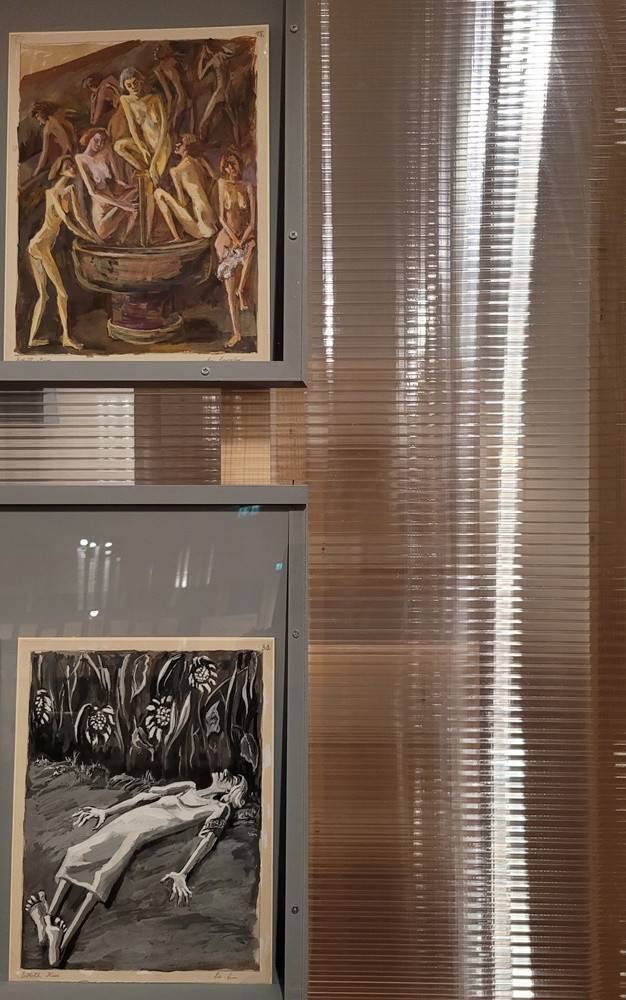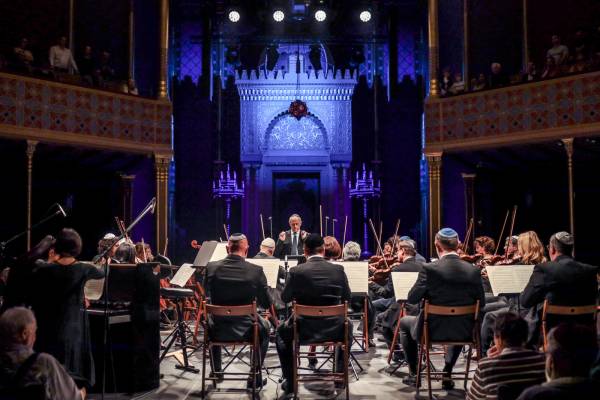Sharp
phantom image and even sharper phantom pain - this is how the exhibition “This
is How it Happened. The Early Memory of the Holocaust in the Works of Eyewitness
Artists” of the Hungarian Jewish Museum and Archives at the Hungarian National
Gallery can be summed up in a nutshell. The exhibited images are images of
crime and criminals, crime scenes and victims, life and death, created by the
most authentic eyewitnesses with the need for documentation and the hope of
being able to process the pain.
It is no
wonder that at the press tour held at the Hungarian National Gallery this
Monday, one of the participants collapsed after half an hour and was unable to
continue watching the...
Watching
what? Not just the pictures, but rather: the reality.
This is
rare, since one does not go to an exhibition with the intention of seeing
reality itself in black and white - after all, one of the most well-known
theses of art enjoyment and art analysis is that it would be a mistake to
question the factuality of a work of art (or more precisely, reality). The
"space" created and displayed by a painting is a mediated,
abstracted, "created" copy of reality, but in this quality, a
picture, a representation is not inferior to reality, even equal to it.
But in
the exhibition "This is How it Happened" one can see such strong
images with such a strong coherence that the verb in the past tense becomes the
present tense. This is how it happens. Yes, people are able do that. Like that,
in the present tense.
The
curator Zsófia Farkas is an art historian from the Jewish Museum, who cannot be
praised enough, as it can be said based on her performance in recent years that
she has an incredible sense of creating a completely new quality by arranging
different works in the same space. Actually, of course, this is (should be) the
task of the curator, just to see an example of an exhibition where there are
pictures, but the organizing principle is missing. Except in the case of Zsófia
Farkas, who conveys thoughts that have been thoroughly thought through,
thoroughly digested, and approached from many, many directions through her
images.

For this
exhibition, the curator painstakingly selected real images and placed them next
to each other, meaning that these images are actually ethical works: the truth
itself, that is, the ethical truth, is called to account, and then the filth of
elementary injustice is revealed to us. It's as if they were just saying: we
know what the truth is, because we have seen man in his bestiality, and we know
why there is no truth, because we have seen death. And now you also see what we
saw, because what happened is happening right now, when you glimpse reality
from the trail of our pencils.
That's
why that spectator collapsed during Monday's press tour. He was experiencing
what he thought was the past in the present tense. This is what real art is
known for: its effect is cathartic, because what it talks about is not
ephemeral, but eternal. Consequently, suffering is also eternal. This is what makes
collapse when the facts of the world penetrate a person's soul at a more
sensitive point.
However,
the representation in this exhibition is factual: this happened, this is how it
happened, and it all happened to us. This happens, this is how it happens, it
all happens to us. The installation is also based on this idea: the pictures
hang on vaguely translucent walls, and from this blurred environment, a sharp
knife cuts out the frame of the works.
And
finally, let us also praise the Hungarian National Gallery, which hosted this
unforgettable exhibition, since the responsibility of a state-run, leading
cultural institution is inestimably important when it comes to processing the
Holocaust. We have already written many times: the Holocaust is not a Jewish
issue, but a Hungarian national issue. This exhibition is not a "Jewish
matter" either, but universal and human.
This
exhibition is a must see for Jews and non-Jews, as much as it hurts. Face
phantoms and feel the phantom pain of a severed limb. In this way, if it is not
forgivable, perhaps what happened will be a little more tolerable. What happens
now.
The
exhibition guides visitors through different sections, thus drawing a specific
arc of the approaches of the artists who witnessed it. The first unit shows how
artists of Jewish origin lived through the period of the growing rise of
anti-Semitism and the increasing disenfranchisement of Jews from the mid-1930s.
After
the German occupation, there are works made in the ghetto, during labor service
and in concentration camps. The peculiarity of the works created at the same
time as the events, on the spot, is that, in addition to documenting, the
experiences ("telling" and processing of them through drawing) could
also help artists to survive.
In the
next section, one can see works made in the two or three years after the
liberation, which often become more symbolic and abstract as the memories
recede, and sometimes they mix the documentary representation of the
experiences with metaphors and imagined scenes. The concrete film frames of
personal memory thus slowly begin to merge with the summarizing images of
collective memory.
The last
section emphasizes the continuity of the eyewitness role: the survivors, whose
work can be understood as a visual indictment of the war, will actually be
draftsmen of court trials when they make drawings of the defendants of the
People's Court trials and the Eichmann trial.
The
exhibition presents the works of nearly 30 artists, including Béla Kádár, Endre
Bálint and Ilka Gedő. Most of the artefacts come from the collection of the
Hungarian Jewish Museum and Archives, which are complemented by works received
from other institutions in Hungary and abroad.
(Source: Hungarian National Gallery)

 01.09. 15:53, kimenete: 01.10. 17:04
01.09. 15:53, kimenete: 01.10. 17:04 





